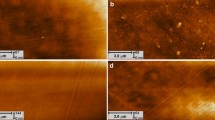Abstract
The capacity of 59 isolates ofSerratia marcescens, obtained from urinary tract infections, wounds, and contact lenses or their paraphernalia, to agglutinate erythrocytes from different animal species was tested. Three main patterns were found: mannose-sensitive agglutination of guinea-pig, fowl or horse erythrocyte; mannose-resistant agglutination of chicken or pigeon erythrocytes alone or in combination with mannose-sensitive agglutination; and no agglutination. Hemagglutination capacity was associated with isolates from urinary tract infection, but not with isolates associated with contact lenses. Adherence to human urinary tract epithelium did not correlate with the hemagglutination patterns nor with the origin of the isolates. Some strains of different hemagglutination pattern were selected for the study of hydrophobicity and adherence to contact lens polymers. Hydrophobicity, as determined by degree of partition in hexadecane and water (BATH-values), correlated neither with degree of adherence to contact lens polymers nor with the hemagglutination pattern. For a representative strain there was an excellent correlation (r2=0.98) between adherence and the water content (hydrophobicity) of the lens polymers. These results suggest that, as with tissues, other factors interact with hydrophobicity in causing adherence to plastics.
Similar content being viewed by others
Literature Cited
Adegbola RA, Old DC (1982) New fimbrial hemagglutinin inSerratia species. Infect Immun 38:306–315
Cooper RL, Constable IJ (1977) Infective keratitis in soft contact lens wearers. Br J Ophthalmol 61:250–254
Denis FA, Blanchard P (1975) Enquete sur les porteurs intestinaux deSerratia. Possibilité d'infections d'origine endogène. Nouv Presse Me'd 4:2114–2115
Duguid JP, Smith IW, Dempster G, Edmunds PN (1955) Nonflagellar appendages (“fimbriae”) and hemaggluting activity inBacterium coli. J Pathol Bacteriol 70:335–348
Duguid JP, Clegg S, Wilson MI (1979) The fimbrial and nonfimbrial hemagglutinins ofEscherichia coli. J Med Microbiol 12:213–2275
Evans DJ Jr, Evans DG, DuPont H (1979) Hemagglutination patterns of enterotoxigenic and enteropathogenicEscherichia coli determined with human, bovine, chicken, and guinea pig erythrocytes in the presence and absence of mannose. Infect Immun 23:336–346
Hagberg L, Jodal U, Korhonen TK, Lidin-Janson G, Lindberg U, Svanborg-Ede'n C (1981) Adhesion, hemagglutination and virulence ofEscherichia coli causing urinary tract infections. Infect Immun 31:564–570
Hermansson, M, Kjelleberg S, Norkrans B (1979) Interaction of pigmented wildtype and pigment-less mutant ofSerratia marcescens with lipid surface film. FEMS Microbiol Lett 6:129–132
Hermannson M, Kjelleberg S, Korhonen TK, Stenstrom T-A (1982) Hydrophobic and electrostatic characterization of surface structure of bacteria and its relationship to adhesion at an air-water interface. Arch Microbiol 86:411–417.
Kaufman HE (1979) Problems associated with prolonged wear soft contact lenses. Am Arch Ophthalmol 86:411–417
Lass JH, Haaf J, Foster CS, Belcher C (1981) Visual outcome in eight cases ofSerratia marcescens keratitis. Am J Ophthalmol 92:384–390
Lemp MA, Blackman H, Wilson LA, Leveille AS (1984) Gram-negative corneal ulcers in elderly aphakic cyes with extended wear lenses. Ophthalmology (Rochester) 91:60–64
Marrie TJ, Costerton JW (1981) Prolonged survival ofSerratia marcescens in chlorhexidine. Appl Environ Microbiol 42:1093–1102
Mayo MS, Schlitzer RL, Ward MA, Wilson LA, Ahearn DG (1984) Association ofPseudomonas andSerratia corneal ulcers with use of contaminated solutions. J. Clin Microbiol 25:1398–1400
Miller MJ, Ahearn DG (1987) Adherence ofPseudomonas aeruginosa to hydrophilic contact lenses and other substrata. J Clin Microbiol 25:1392–1397
Miller MJ, Wilson LA, Ahearn DG (1991) Adherence ofPseudomonas aeruginosa to rigid gas-permeable contact lenses. Arch Ophthalmol 109:1447–1448
Old D, Adegbola R, Scott SS (1983) Multiple fimbrial hemagglutinins inSerratia species. Med Microbiol Immunol 172:107–115
Parment PA (1983) Absence ofSerratia marcescens in fecal samples from normal individuals. Infection 11:175
Parment PA, Ronnerstam RA (1981) Soff contact lens keratitis associated withSerratia marcescens. Acta Ophthalmol (Copenh) 59:560–565
Penley CA, Schlitzer RL, Ahearn DG, Wilson LA (1981) Laboratory evaluation of chemical disinfection of soft contact lenses. Contact Intraocular Lens Med J 7:101–110
Pringle JH, Fletcher M (1986) Influence of substratum hydration and absorbed macromolecules on bacterial attachment to surfaces. Appl Environ Microbiol 51:1321–1325
Rosenberg M, Gutnick D, Rosenberg E (1980) Adherence of bacteria to hydoocarbons: a simple method for measuring cell-surface hydrophobicity. FEMS Microbiol Lett 9:29–33
Starr MP, Grimont PAD, Grimont F, Starr PB (1976) Caprylate-thallous agar medium for selectively isolatingSerratia and its utility in the clinical laboratory. J Clin Microbiol 4:270–276
Surgalla MJ, Beesley ED (1969) Congo red agar plating medium for detecting pigmentation inPasteurella pestis. Appl Microbiol 18:834–837
Wilson LA, Sawant AD, Ahearn DG (1991) Comparative efficacies of soft contact lens disinfectant solutions against microbial films in lens cases. Arch Ophthalmol 109:1155–1157
Yamamoto T, Ariyoshi A, Amako K (1985) Fimbria mediated adherence ofSerratia marcescens strain US5 to human urinary bladder surface. Microbiol Immunol 29:677–681
Author information
Authors and Affiliations
Rights and permissions
About this article
Cite this article
Parment, P.A., Svanborg-Ede'n, C., Chaknis, M.J. et al. Hemagglutination (fimbriae) and hydrophobicity in adherence ofSerratia marcescens to urinary tract epithelium and contact lenses. Current Microbiology 25, 113–118 (1992). https://doi.org/10.1007/BF01570969
Issue Date:
DOI: https://doi.org/10.1007/BF01570969




